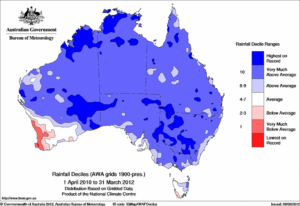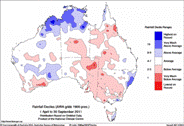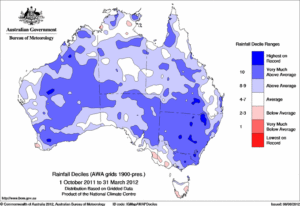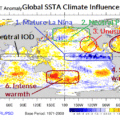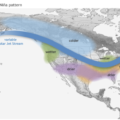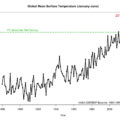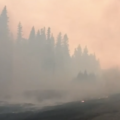SOI: Strong
SST: Moderate to Strong
The 2010–12 La Niña event consisted of two peaks over successive summers; the 2010–11 peak was one of the strongest on record, comparable in strength with the events of 1917–18, 1955–56 and 1975–76. In October and December 2010, and February and March 2011, monthly Southern Oscillation Index values were the highest on record (records commenced in 1876). The 2011–12 peak was weaker, but still ofmoderate strength, in both atmospheric and oceanic indicators.
2010 and 2011 were the third-wettest and second-wettest calendar years on record for Australia, with 703 mm and 708 mm respectively, both well above the long-term average of 465 mm. Combined, the two events yielded Australia’s wettest 24-month period on record (April 2010 to March 2012, Figure 1), and wettest two-calendar-year period (2010–2012), with 1411 mm of rainfall, topping the previous record of 1407 mm in 1973–1974.
The first year of the event followed a typical La Niña pattern, emerging in autumn 2010 and strengthening over winter. A dry June in 2010 was followed by significantly higher than average rainfall over the nine months from July 2010 to March 2011 (Figure 2). The SOI weakened and returned to neutral values during winter 2011. The six months from April to September 2011 (Figure 3) were relatively dry over much of Australia under neutral ENSO conditions. The SOI rose, again in spring 2011 and above-average rainfall returned to most of mainland Australia for the six months from October 2011 to March 2012 (Figure 4), although totals were not as exceptional as during the 2010–11 period.
Flooding was widespread between September 2010 and March 2011. As well as severe flooding in southeast Queensland, large areas of northern and western Victoria, New South Wales, northwestern Western Australia, and eastern Tasmania were subject to significant flooding. Widespread flooding across southeast Australia resulted in a significant increase in mosquito-borne diseases; 1092 cases of Ross River Virus were detected in Victoria between January and April, and 151 cases of Barmah Forest Virus. The tropics also experienced some highly unseasonable rain events during late autumn and winter 2010, in what is typically the dry season. Abundant vegetation growth following high rainfall in the usually arid interior fuelled widespread grassfires in central and northern Australia between August and November 2011. Much of inland southern and far northern Queensland, most of New South Wales, northern Victoria, and central Australia experienced flooding at least once between late November 2011 and March 2012.
Several notable tropical cyclones occurred during the summers of 2010–11 and 2011–12. Severe tropical cyclone Yasi was the most significant – Yasi was the strongest cyclone to make landfall in Queensland since at least 1918 (also a La Niña year), crossing the coast near Mission Beach, between Cairns and Townsville, as a category 5 storm. Other notable cyclones during the two La Niña events included Carlos,Grant, and Lua.


